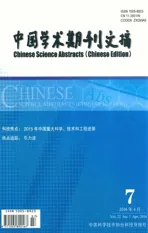引力波
2016-06-14
引力波
爱因斯坦于1916年提出了广义相对论,根据广义相对论,物理学家先后提出了4个预言,即光线在引力场中的偏折,光谱线在引力场中的红移,引力波存在和黑洞存在。作为广义相对论中最重要预言的引力波,由于其十分微弱,所以很难被探测到,一直以来都是物理学和天文学重点研究的对象。20世纪70年代,普林斯顿大学物理学家拉塞尔·赫尔斯和约瑟夫·泰勒观测到一个脉冲星与另一个天体相互绕转组成的双星系统,后来发现第二个天体是一个中子星。这个系统由于辐射引力波,导致脉冲星的轨道缓慢地缩小,观测到的轨道变化率与相对论的预言高度一致,给出了引力波存在的第一个间接证据。2016年2月11日,激光干涉引力波天文台(Laser Interferometer Gravitational Wave Observatory,简称LIGO)项目主管大卫·莱兹在华盛顿举行的新闻发布会上宣布人类首次直接探测到引力波的存在。相关论文发表在2016年2月11日在线出版的《Physical Review Letters》上。
黑洞并合等天体物理过程产生的引力波还可以利用校准后的毫秒脉冲星、空间卫星阵列等方式探测。此外还有一种尤为独特的引力波,天文学家称之为“原初引力波”。这种引力波产生于宇宙大爆炸的一瞬间,其波长跟整个宇宙的尺度差不多,所以只能通过宇宙微波背景辐射信号中留下的蛛丝马迹来寻找原初引力波的信号。中国计划在西藏阿里地区利用高海拔大气高透过率的特点开展原初引力波的探测实验。引力波的探测是当前物理学重要的前沿领域之一,有助于人类更加清楚地了解宇宙的起源和运行机制,为人类提供观测宇宙的一个新窗口。
本专题得到李芳昱教授(重庆大学物理学院)的大力支持。
截至2016年2月29日,中国知网(CNKI)和Web of Science(WOS)的数据报告显示,以“引力波”为词条可以检索到的期刊文献分别为223与 4194条,本专题将相关数据按照:研究机构发文数、作者发文数、期刊发文数、被引用频次进行排行,结果如下。
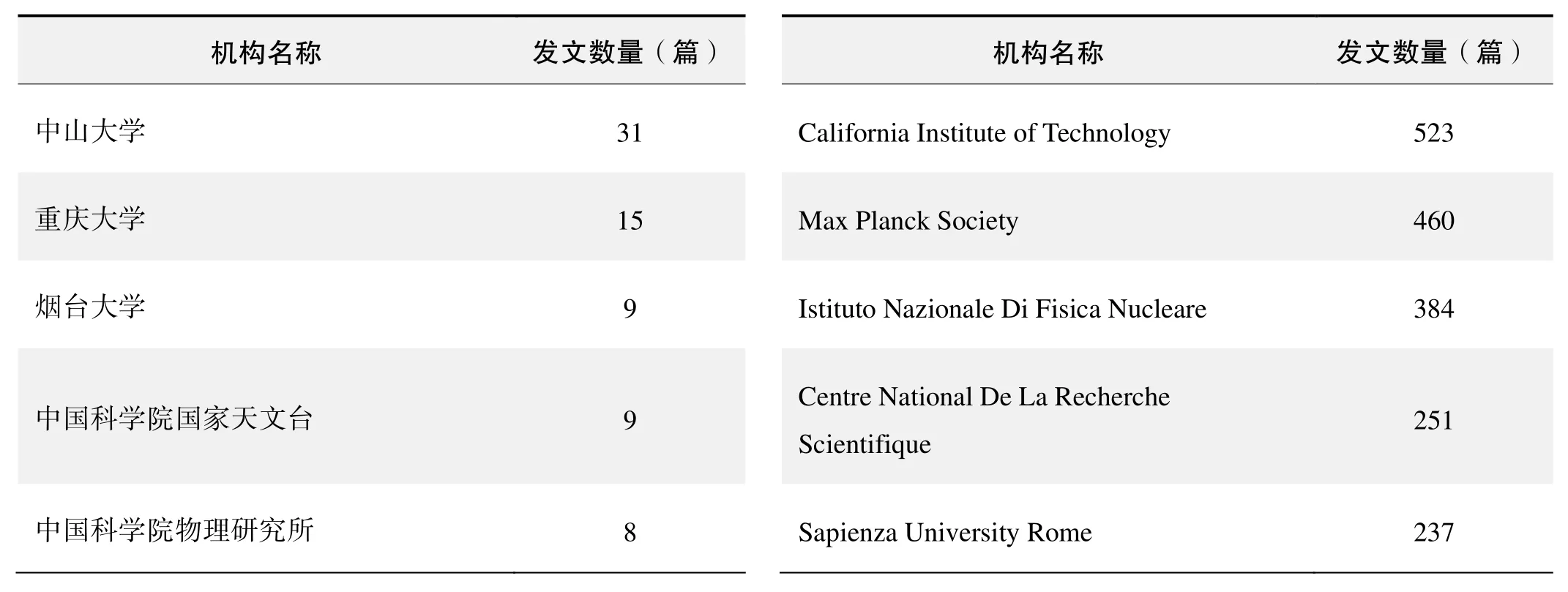
研究机构发文数量排名(CNKI) 研究机构发文数量排名(WOS)
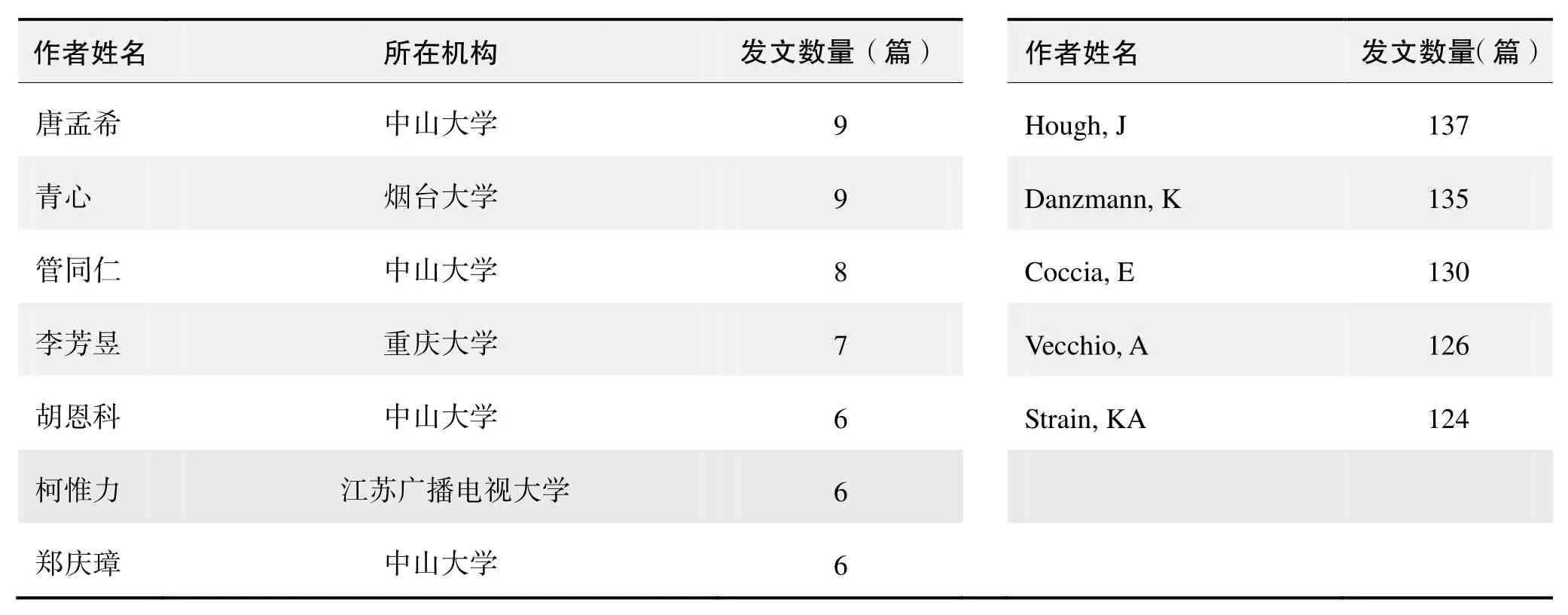
作者发文数量排名(CNKI) 作者发文数量排名(WOS)

期刊发文数量排名(CNKI) 期刊发文数量排名(WOS)
根据中国知网(CNKI)数据报告,以“引力波”为词条可以检索到的高被引论文排行结果如下。
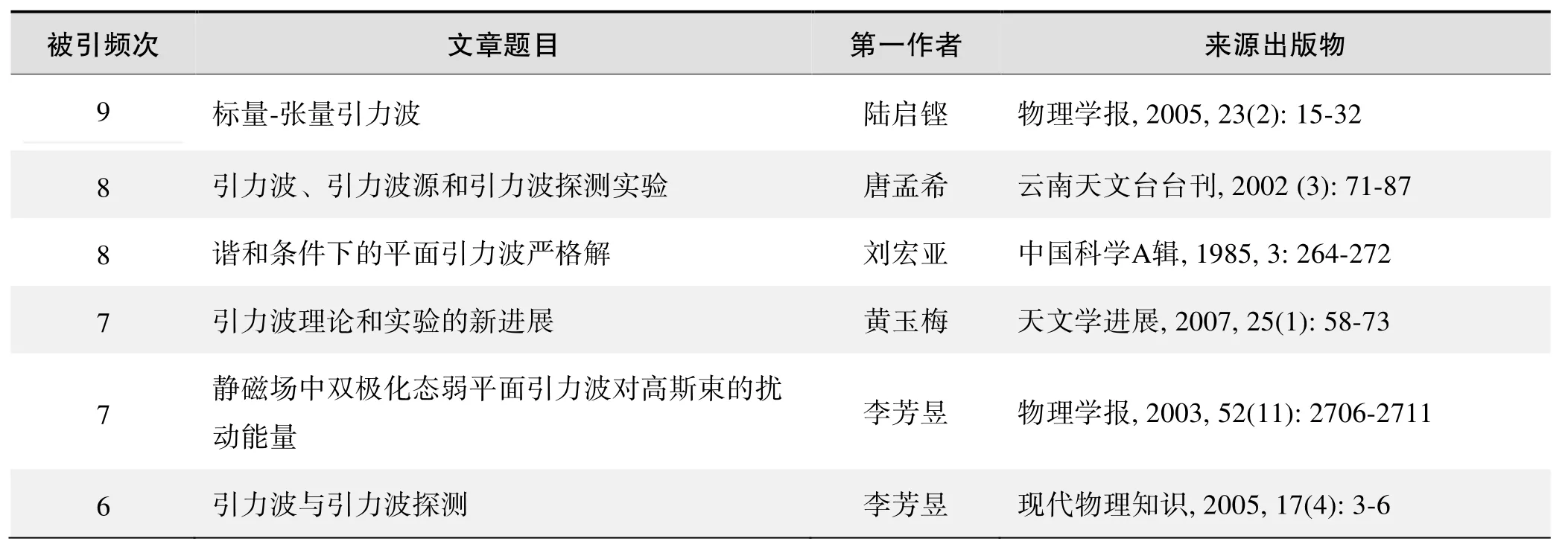
国内数据库高被引论文排行

续表
根据Web of Science统计数据,以“引力波”为词条可以检索到的高被引论文排行结果如下。
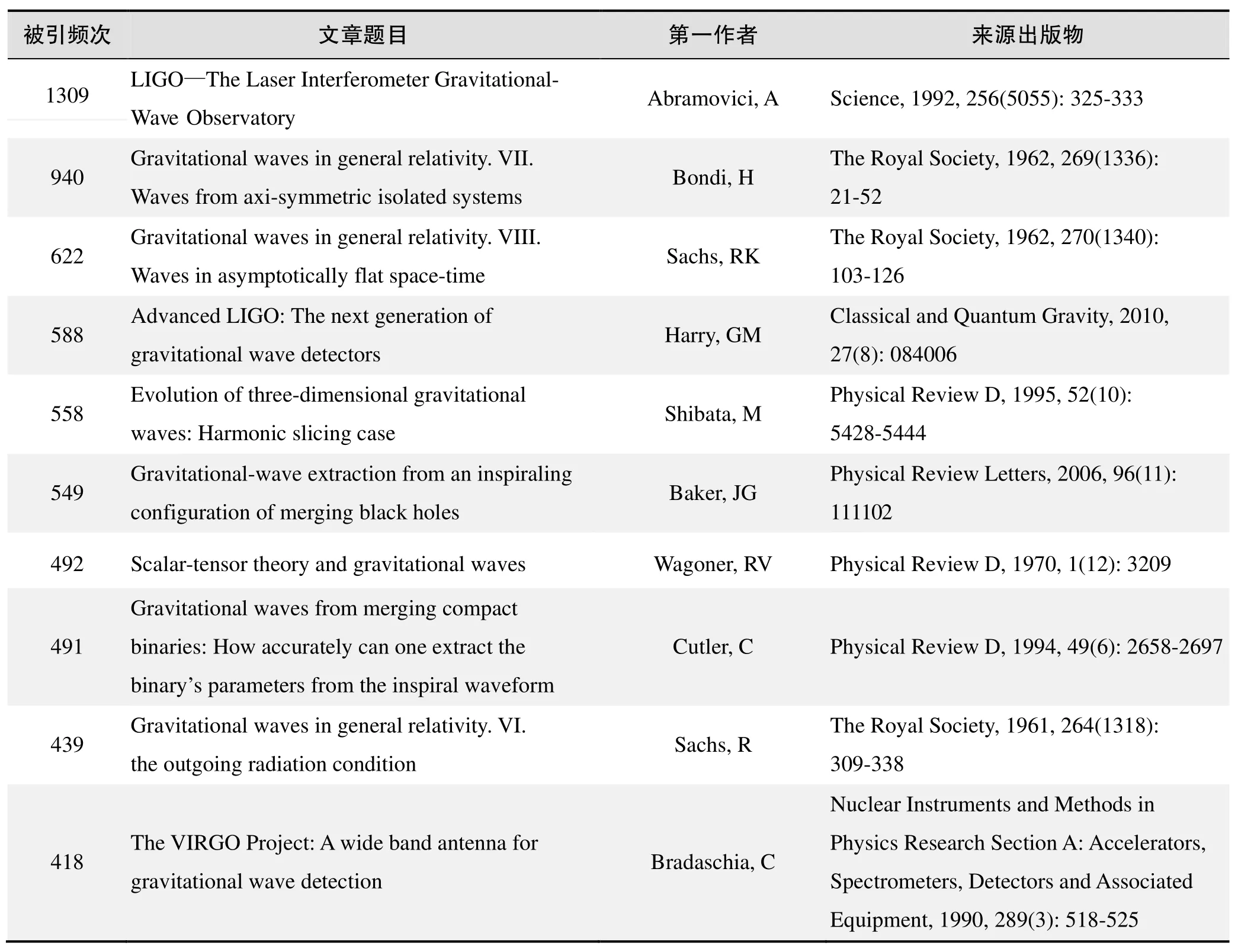
国外数据库高被引论文排行
基于Web of Science检索结果,利用Histcite软件选取LCS(Local Citation Score,本地引用次数)TOP 30文献作为节点进行分析,得到本领域推荐的经典文献如下。
来源出版物:Physical Review, 1960, 117(1): 306-313
Determining the hubble constant from gravitational-wave observations
Schutz, BF Abstract: I report here how gravitational wave observations can be used to determine the Hubble constant, H0. The nearly monochromatic gravitational waves emitted
by the decaying orbit of an ultra-compact, two-neutron-star binary system just before the stars coalesce are very likely to be detected by the kilometre- sized interferometric gravitational wave antennas now being designed. The signal is easily identified and contains enough information to determine the absolute distance to the binary, independently of any assumptions about the masses of the stars. Ten events out to 100 Mpc may suffice to measure the Hubble constant to 3% accuracy.
来源出版物:Nature, 1986, 323(6086): 310-311
The VIRGO Project: A wide band antenna for gravitational wave detection
Bradaschia, C; Delfabbro, R; Divirgilio, A; et al.
Abstract: The status of advancement of the VIRGO Project is presented: the first-generation results from the Pisa seismic noise super attenuator give an upper limit to the noise transfer function of 2×10¯8at 10 Hz. The upper limit to the absolute noise of the 400 kg test mass at 10 Hz has been measured to be 1.5×10¯13m/Hz. The scheme and the related problems of the VIRGO interferometer, which is supposed to work down to 10 Hz, are also presented. At the 3rd Pisa Meeting in 1986 we presented the idea of what could be a very efficient seismic noise reduction system able to give a sensitivity h~10¯25at 10 Hz, in a 3 km interferometer for 1 year integration time. Now we have two new facts to present: the first is that the attenuation has been built, is working in Pisa, and shows remarkable
characteristics. The second is the Italian-French interferometer VIRGO, a 3 km long antenna for low and high frequency (10-1000 Hz) gravitational wave (GW) detection.
来源出版物:Nuclear Instruments and Methods in Physics Research Section A: Accelerators, Spectrometers, Detectors and Associated Equipment, 1990, 289(3): 518-525
The last 3 minutes: Issues in gravitational-wave measurements of coalescing compact binaries
Cutler, C; Apostolatos, TA; Bildsten, L; et al.
Abstract: Gravitational-wave interferometers are expected to monitor the last three minutes of inspiral and final coalescence of neutron star and black hole binaries at distances approach cosmological, where the event rate may be many per year. Because the binary's accumulated orbital phase can be measured to a fractional accuracy ≪ 10-3and relativistic effects axe large, the wave forms will be far more complex and carry more information than has been expected. Improved wave form modeling is needed as a foundation for extracting the waves’ information, but is not necessary for wave detection.
来源出版物:Physical Review Letters, 1993, 70(20): 2984-2987
Search templates for gravitational waves from inspiraling binaries: Choice of template spacing
Owen, BJ Abstract: Gravitational waves from inspiraling, compact binaries will be searched for in the output of the LIGO-VIRGO interferometric network by the method of‘‘matched filtering’’—i.e., by correlating the noisy output of each interferometer with a set of theoretical wave form templates. These search templates will be a discrete subset of a continuous, multiparameter family, each of which approximates a possible signal. The search might be performed hierarchically, with a first pass through the data using a low threshold and a coarsely spaced, few-parameter template set, followed by a second pass on threshold-exceeding data segments, with a higher threshold and a more finely spaced template set that might have a
larger number of parameters. Alternatively, the search might involve a single pass through the data using the larger threshold and finer template set. This paper extends and generalizes the Sathyaprakash-Dhurandhar (SD) formalism for choosing the discrete, finely spaced template set used in the final (or sole) pass through the data, based on the analysis of a single interferometer. The SD formalism is rephrased in geometric language by introducing a metric on the continuous template space from which the discrete template set is drawn. This template metric is used to compute the loss of signal-to-noise ratio and reduction of event rate which result from the coarseness of the template grid. Correspondingly, the template spacing and total number N of templates are expressed, via the metric, as functions of the reduction in event rate. The theory is developed for a template family of arbitrary dimensionality (whereas the original SD formalism was restricted to a single nontrivial dimension). The theory is then applied to a simple post1-Newtonian template family with two nontrivial dimensions. For this family, the number of templates N in the finely spaced grid is related to the spacing-induced fractional loss L of event rate and to the minimum mass Mmin of the least massive star in the binaries for which one searches by N~2×105(0.1/L) (0.2M⊙/Mmin)2.7for the first LIGO interferometers and by N~8×106(0.1/L)(0.2M⊙/Mmin)2.7for advanced LIGO interferometers. This is several orders of magnitude greater than one might have expected based on Sathyaprakash’s discovery of a near degeneracy in the parameter space, the discrepancy being due to that paper’s high choice of Mmin and less stringent choice of L. The computational power P required to process the steady stream of incoming data from a single interferometer through the closely spaced set of templates is given in floating-point operations per second by P~3×1010(0.1/L)(0.2M⊙/Mmin)2.7for the first LIGO interferometers and by P~4×1011(0.1/L) (0.2M⊙/Mmin)2.7for advanced LIGO interferometers. This will be within the capabilities of LIGO-era computers, but a hierarchical search may still be desirable to reduce the required computing power.
来源出版物:Physical Review D, 1996, 53(12): 6749-6761
Detection and generation of gravitational waves
Weber, J
Abstract:Methods are proposed for measurement of the Riemann tensor and detection of gravitational waves. These make use of the fact that relative motion of mass points, or strains in a crystal, can be produced by second derivatives of the gravitational fields. The strains in a crystal may result in electric polarization in consequence of the piezoelectric effect. Measurement of voltages then enables certain components of the Riemann tensor to be determined. Mathematical analysis of the limitations is given. Arrangements are presented for search for gravitational radiation. The generation of gravitational waves in the laboratory is discussed. New methods are proposed which employ electrically induced stresses in crystals. These give approximately a seventeen-order increase in radiation over a spinning rod of the same length as the crystal. At the same frequency the crystal gives radiation which is about thirty-nine orders greater than that of a spinning rod.
文献编号本领域经典文章题目第一作者来源出版物1 Detection and generation of gravitational waves Weber, J Physical Review, 1960, 117(1): 306-313 2 Determining the hubble constant from gravitational-wave observations Schutz, BF Nature, 1986, 323(6086): 310-311 3The VIRGO Project: A wide band antenna for gravitational wave detection Bradaschia, C Nuclear Instruments and Methods in Physics Research Section A: Accelerators, Spectrometers, Detectors and Associated Equipment , 1990, 289(3): 518-525 4 The last 3 minutes: Issues in gravitational-wave measurements of coalescing compact binaries Cutler, C Physical Review Letters, 1993, 70(20): 2984-2987 5 Search templates for gravitational waves from inspiraling binaries: Choice of template spacing Owen, BJ Physical Review D, 1996, 53(12): 6749-6761
